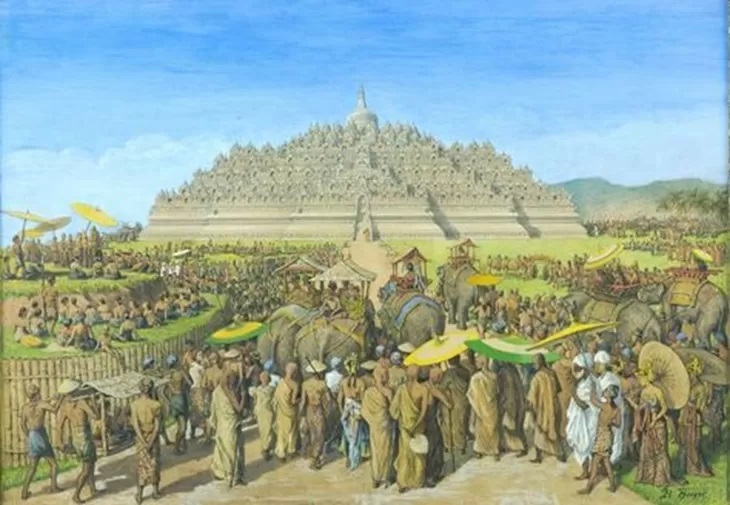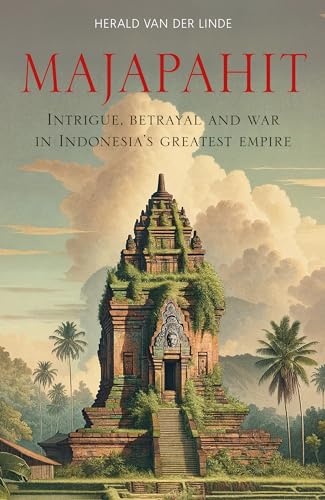
Book review of Majapahit: Intrigue, Betrayal and War in Indonesia’s Greatest Empire by Herald Van Der Linde (Monsoon Books, 2024).
The ancient history of the Malay Archipelago is a fascinating field of study. However, one of the main challenges in writing such history lies in the sources. Traditional historiography of the Malay world differs significantly from the objective, modern style of historiography.[1] Thus, historians are tasked with doing extra work to verify traditional accounts using various methods, including archaeology. Although never entirely conclusive, archaeology has helped modern scholars to better understand the past and to develop new historical narratives.[2] Using all of these sources and methodologies, Herald Van Der Linde has written his book, Majapahit: Intrigue, Betrayal, and War in Indonesia’s Greatest Empire.
The book was brilliant, captivating, and well-researched. As a student of history, I read it with great enthusiasm—particularly the endnotes, which revealed the sources Van Der Linde used for his stories. The book draws on two important primary sources: the Desawarnana and the Pararaton. Although I regard this work as a historical masterpiece, it is not without flaws.
In my view, the most significant flaw of the book is the Eurocentric and colonialist approach that Van Der Linde adopts, especially in the introduction. Although this book is about the ancient Javanese kingdom, Van Der Linde chose to introduce the subject through the story of a colonial figure, such as Raffles. I felt that Van Der Linde devoted far too many pages on Raffles, which was unnecessary. If his name needed to be mentioned at all, it should have been noted in the footnote, not in the main text, as the book should focus on Majapahit, not a later colonial officer.
The colonial narrative is also evident when Van Der Linde attempts to justify the brutal Dutch attacks on the natives. For example, to justify the Dutch assault on Bali, the natives are portrayed as “brutal.”[3] Thus creating a rationale that the native deserved to be attacked. The Eurocentric perspective is clearly evident. In Van Der Linde’s narrative, the natives always seem to need Europeans to save them and preserve their history. Majapahit is said to have been forgotten, except “for a few foreign adventurers”.[4] Although the Dutch were actually robbers and thieves, they are portrayed as discoverers and saviors in Van Der Linde’s text. For example, the Dutch looted and burned a palace in Lombok, Bali, in 1894. Instead of condemning the looters as criminals, Van Der Linde elevates one of them—Jan Laurens Andries Brandes—to the status of a discoverer, simply because, instead of gold, he looted some native manuscripts. This thief was said to put “Majapahit back on the map”.[5] Apart from its Eurocentric and colonialist narrative, the book is excellent.

My favorite part of the book was the story of Mpu Prapanca. He was an anchient writer who deviated from the typical writing style of his time and, in doing so, created a hugely important historical document about Majapahit—the Desawarnana. Instead of writing about epic battles filled with diety, demons, gods, and romantic tales full of emotional intrigue, Prapanca focused on the everyday lives of the people in Majapahit.[6] This story is very important to me, as it teaches us that doing something different is important. Writing about ordinary things is important. This is what Prapanca showed us. His Desawarnana eventually caught the attention of Balinese copyists, who preserved and reproduced the text. It has survived to this day and become a primary source for scholars seeking to understand ancient Majapahit.
The study of Majapahit’s history also helps us understand how society evolved. Van Der Linde noted that long before kingdoms were established in the land of Java, religions such as Buddhism and Hinduism had already spread throughout the region. This spread was not the result of military conquest, but occurred slowly and gradually through the arrival of sailors, merchants, and traders.[7] I found some of the spiritual quotes mentioned by Van Der Linde from the Majapahit era very inspiring. My favorite is: “Pain is inevitable, suffering is optional.”[8]
Beyond spirituality, one historical detail that caught my attention was the early mention of Melaka in the Majapahit records. Melaka was referenced during the time of Patih Gajah Mada and was said to be an ally of the Javanese warrior Kembar.[9] In the Pararaton, Melaka was mentioned as “Pamelekahan,” which some scholars believe to be the earliest recorded reference to Melaka in historical sources.[10] According to Van Der Linde, the rise of Melaka marked the first time a powerful Muslim kingdom emerged on Majapahit’s doorstep.[11]
After Mpu Prapanca, my favorite figure in the history of Majapahit is the wise and progressive Queen Suhita, who ruled during the final years of the empire. Suhita was scarred for life after witnessing the burning of her companions during the Hindu ritual of sati when she was still a child.[12] The word setia, meaning “loyal,” is believed to have originated from this ritual.[13] Suhita ruled during a time of great change, and instead of resisting it, she embraced it. She loved debates and valued the opinions of others. She don’t mind speaking with commoners on the streets to understand their problems. She governed the country effectively, helped save the population from famine, allowed Muslims to build their mosques, and cleverly hoodwinked Hindu priests who believed their outdated rituals were eternal. For me, Suhita is a historical figure who is both fascinating and enjoyable to read about.
Overall, I found the historical narrative presented by Herald Van Der Linde to be very engaging. I’m also aware that such a narrative would be impossible to craft without making certain simplifications and assumptions—something historians loathed —but I believe it was a fair trade-off, as it successfully brought the interest on ancient history back to the fore.
Bibliography
Nasha Rodziadi Khaw, Nazarudin Zainun, and Suresh Narayanen. 2024. Kedah Tua: Sejarah, Arkeologi & Naratif Baharu. Pulau Pinang: Penerbit Universiti Sains Malaysia & Think City.
Syed Ahmad Fathi. 2023. “Persejarahan Melayu Tradisional.” Nota Pengajian Sejarah.
Van Der Linde, Herald. 2024. Majapahit: Intrigue, Betrayal and War in Indonesia’s Greatest Empire. Monsoon Books.
[1] Syed Ahmad Fathi. “Persejarahan Melayu Tradisional.” Nota Pengajian Sejarah (2023).
[2] Nasha Rodziadi Khaw, Nazarudin Zainun, dan Suresh Narayanen. Kedah Tua: Sejarah, Arkeologi & Naratif Baharu. Pulau Pinang: Penerbit Universiti Sains Malaysia & Think City, 2024.
[3] Herald Van Der Linde, Majapahit: Intrigue, Betrayal and War in Indonesia’s Greatest Empire (Monsoon Books, 2024)., pg. 21.
[4] Ibid., pg. 19.
[5] Ibid., pp. 20-22.
[6] Ibid., pg. 31.
[7] Ibid., pg. 42.
[8] Ibid., pg. 90.
[9] Ibid., pg. 181.
[10] See end note No. 328 in Herald Van Der Linde, Majapahit: Intrigue, Betrayal and War in Indonesia’s Greatest Empire (Monsoon Books, 2024)., pg. 323.
[11] Herald Van Der Linde, Majapahit: Intrigue, Betrayal and War in Indonesia’s Greatest Empire (Monsoon Books, 2024)., pg. 227. Van Der Linde also noted that the first Muslim sultanate in the acipelago was not Melaka but Aceh in North Sumatera. Aceh Sultanate was founded before Majapahit was founded by Hayam Wuruk’s grandfather, see end notes No. 475 on pg. 333.
[12] Ibid., pg. 233.
[13] See end note No. 96 in Herald Van Der Linde, Majapahit: Intrigue, Betrayal and War in Indonesia’s Greatest Empire (Monsoon Books, 2024)., pg. 306.
Author of several books including Berfikir Tentang Pemikiran (2018), Lalang di Lautan Ideologi (2022), Dua Sayap Ilmu (2023), Resistance Sudah Berbunga (2024), Intelektual Yang Membosankan (2024), Homo Historikus (2024), DemokRasisma (2025), dan Dari Orientalisma Hingga ke Genosida (2025). Fathi write from his home at Sungai Petani, Kedah. He like to read, write and sleep.